Tag Archives: minute
30th Anniversary Of Women In Combat Aviation Maj Gen Jeannie M Leavitt 1 Minute Version
IBM US Army Air Force 24hr Vintage Minute Impulse Secondary Slave Clock WORKS
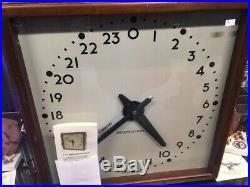







The size is 19.5 x 19.5 x 4 3/8 inches deep. The following information has been researched and compiled by the volunteers of the National Museum of World War II Aviation in Colorado Springs, CO. 100% of the proceeds from the sales of this item will be reinvested into the museum’s programs. We have several of these clocks available and will be listing them all over time. If you have additional requests for information, we will be happy to respond to messages within 48 hours. Your International clock is a vintage Minute Impulse Secondary Clock also called? Manufactured in the early 1940s by International Business Machines Corporation, better known today as IBM. The Endicott, NY plant that made it was built in 1906 and the building is still used by IBM today. Your clock is one of a lot discovered in old unopened wooden crates obtained by the museum in 2014. The clocks were made for the US Army Air Force (AAF), the successor to the Army Air Corps and the forerunner of today? S US Air Force. Serial numbers indicate they were made in 1942 and 1943. They were inspected, packaged and crated at the AAF? S 829th Specialized Depot (829 SP D) at Gadsden, Alabama, in July 1945, shortly before the end of WWII. Between manufacturing and crating, they may have been in service or in storage; we have no way of knowing for certain, but some do appear to show wear from use. Four clocks were packed per crate with each clock wrapped in brown paper and then sealed against moisture with tarred paper. Even so, after 70 years of slow oxidation the mechanisms had become inoperable. Museum restoration staff disassembled, cleaned and restored these to operating condition using all the original parts (unless broken or beyond repair). The 829th SP D inspection tag from its outer wrapper accompanies your clock. Minute Impulse Secondary Clocks. Invented around the turn of the 20th Century, secondary (slave) clocks were used in large institutions such as factories, schools and military bases that needed to show the same time in many locations at once. Large numbers of secondary clocks could be remotely controlled over wires by a master clock that might be located in a principal? S office for a school or a headquarters office for the military. Master/slave time systems are still in production using modern technologies. The impulse type of secondary clock is not a true clock; by itself, it cannot keep time. The minute-impulse clock received a pulse of current from its master clock each minute to advance the hands. Minute impulse clocks are sturdy and use no power save a small amount when advancing the hands. The basic design of your clock was first patented in 1928 by Clinton E. Larrabee and assigned to the International Time Recording Company, Ltd. One of the forefather firms that eventually became IBM. A master clock was a precision time-keeping device that, for your clock model, sent a 24-volt pulse over a pair wires each minute to advance all the hands of all its slave clocks (note that this model, 561-2CG, did not come with second hands). At five minutes to the hour, a temporary change occurred to the scheme to correct any clock that had missed one or more pulses. Note: we have placed a small jumper wire across the switch terminals. The switch is not used and the jumper prevents possible poor contact problems. S Clock Driver Unit. Museum staff designed and constructed a small clock driver unit powered by a? To provide master clock pulses so your clock can keep time. A fast-forward switch on the driver box can be used to advance the clock if it falls behind the actual time. Fast-forward advances the hands by 3 minutes per second and through 24 hours in just eight minutes. If your clock is close to a full 24 hours behind, you may find it easier to turn it off, let it fall a little behind actual time, and then fast forward to set it. A green LED lights when power is applied and it winks each time a pulse is sent to the clock. Some of these clocks also have a buzzer attached to the back of the case. These operate on 24 volts AC, but we have not provided a unit to power them. It does not matter which way the clock? S wires are attached to the screw terminals on the driver box; it is not polarity sensitive. The red wire goes to one terminal and the black and green wires to the other (note the original wire colors are faded by time). The construction of these antique clocks imposes some operating limitations. They cannot be reset by pushing the hands around because there is no way to open the front of the clock. Accessing the hands requires taking the case apart from the back. And the internal mechanism can only be advanced, not run backward; therefore, setting them sometimes requires a bit of patience, as befits a product of a simpler time. Finally, though the clocks sport a gray Greenwich Mean Time (GMT) hand, it is fixed in relation to the black hour hand; therefore, wherever Daylight Savings Time is in use, the GMT offset cannot be relied upon to be correct. Reading Your Serial Number. S serial number is on a label on the clock? The Model number on the label, 561-2CG, apparently refers only to the impulse mechanism because we have seen the same model number on several quite different-looking clock case designs. The Catalog number on the label apparently defined the actual case appearance. All sales are final. However, if your clock stops working, please contact the Museum. We will make every attempt to try to solve the problem. The item “IBM US Army Air Force 24hr Vintage Minute Impulse Secondary Slave Clock WORKS” is in sale since Saturday, July 13, 2019. This item is in the category “Collectibles\Clocks\Vintage (1930-69)\Wall”. The seller is “namowwiia” and is located in Colorado Springs, Colorado. This item can be shipped to United States.
- Country/Region of Manufacture: United States
- Brand: IBM

IBM US Army Air Force 24hr Vintage Minute Impulse Secondary Slave Clock WORKS

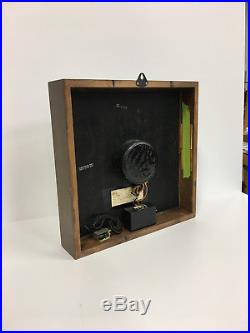
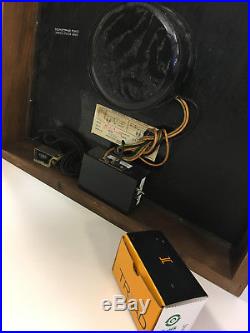


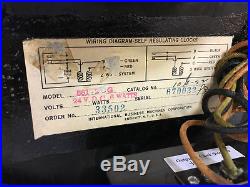
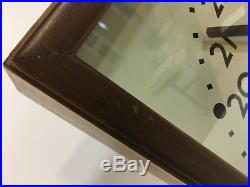
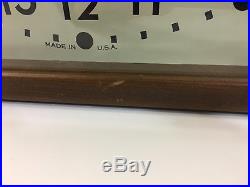


The size is 19.5 x 19.5 x 4 3/8 inches deep. The following information has been researched and compiled by the volunteers of the National Museum of World War II Aviation in Colorado Springs, CO. 100% of the proceeds from the sales of this item will be reinvested into the museum’s programs. We have several of these clocks available and will be listing them all over time. If you have additional requests for information, we will be happy to respond to messages within 48 hours. Your International clock is a vintage Minute Impulse Secondary Clock (also called slave clock) manufactured in the early 1940s by International Business Machines Corporation, better known today as IBM. The Endicott, NY plant that made it was built in 1906 and the building is still used by IBM today. Your clock is one of a lot discovered in old unopened wooden crates obtained by the museum in 2014. The clocks were made for the US Army Air Force (AAF), the successor to the Army Air Corps and the forerunner of todays US Air Force. Serial numbers indicate they were made in 1942 and 1943. They were inspected, packaged and crated at the AAFs 829th Specialized Depot (829 SP D) at Gadsden, Alabama, in July 1945, shortly before the end of WWII. Between manufacturing and crating, they may have been in service or in storage; we have no way of knowing for certain, but some do appear to show wear from use. Four clocks were packed per crate with each clock wrapped in brown paper and then sealed against moisture with tarred paper. Even so, after 70 years of slow oxidation the mechanisms had become inoperable. Museum restoration staff disassembled, cleaned and restored these to operating condition using all the original parts (unless broken or beyond repair). The 829th SP D inspection tag from its outer wrapper accompanies your clock. Minute Impulse Secondary Clocks. Invented around the turn of the 20th Century, secondary (slave) clocks were used in large institutions such as factories, schools and military bases that needed to show the same time in many locations at once. Large numbers of secondary clocks could be remotely controlled over wires by a master clock that might be located in a principals office for a school or a headquarters office for the military. Master/slave time systems are still in production using modern technologies. The impulse type of secondary clock is not a true clock; by itself, it cannot keep time. The minute-impulse clock received a pulse of current from its master clock each minute to advance the hands. Minute impulse clocks are sturdy and use no power save a small amount when advancing the hands. The basic design of your clock was first patented in 1928 by Clinton E. Larrabee and assigned to the International Time Recording Company, Ltd. One of the forefather firms that eventually became IBM. A master clock was a precision time-keeping device that, for your clock model, sent a 24-volt pulse over a pair wires each minute to advance all the hands of all its slave clocks (note that this model, 561-2CG, did not come with second hands). At five minutes to the hour, a temporary change occurred to the scheme to correct any clock that had missed one or more pulses. Note: we have placed a small jumper wire across the switch terminals. The switch is not used and the jumper prevents possible poor contact problems. The Museums Clock Driver Unit. Museum staff designed and constructed a small clock driver unit powered by a wall wart to provide master clock pulses so your clock can keep time. A fast-forward switch on the driver box can be used to advance the clock if it falls behind the actual time. Fast-forward advances the hands by 3 minutes per second and through 24 hours in just eight minutes. If your clock is close to a full 24 hours behind, you may find it easier to turn it off, let it fall a little behind actual time, and then fast forward to set it. A green LED lights when power is applied and it winks each time a pulse is sent to the clock. Some of these clocks also have a buzzer attached to the back of the case. These operate on 24 volts AC, but we have not provided a unit to power them. It does not matter which way the clocks wires are attached to the screw terminals on the driver box; it is not polarity sensitive. The red wire goes to one terminal and the black and green wires to the other (note the original wire colors are faded by time). The construction of these antique clocks imposes some operating limitations. They cannot be reset by pushing the hands around because there is no way to open the front of the clock. Accessing the hands requires taking the case apart from the back. And the internal mechanism can only be advanced, not run backward; therefore, setting them sometimes requires a bit of patience, as befits a product of a simpler time. Finally, though the clocks sport a gray Greenwich Mean Time (GMT) hand, it is fixed in relation to the black hour hand; therefore, wherever Daylight Savings Time is in use, the GMT offset cannot be relied upon to be correct. Reading Your Serial Number. Your clocks serial number is on a label on the clocks backside. The Model number on the label, 561-2CG, apparently refers only to the impulse mechanism because we have seen the same model number on several quite different-looking clock case designs. The Catalog number on the label apparently defined the actual case appearance. All sales are final. However, if your clock stops working, please contact the Museum. We will make every attempt to try to solve the problem. The item “IBM US Army Air Force 24hr Vintage Minute Impulse Secondary Slave Clock WORKS” is in sale since Thursday, December 21, 2017. This item is in the category “Collectibles\Clocks\Vintage (1930-69)\Wall”. The seller is “namowwiia” and is located in Colorado Springs, Colorado. This item can be shipped to United States.
- Brand: IBM
- Country/Region of Manufacture: United States

IBM US Army Air Force 24hr Vintage Minute Impulse Secondary Slave Clock WORKS
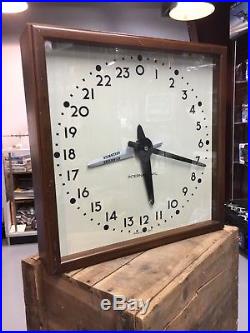
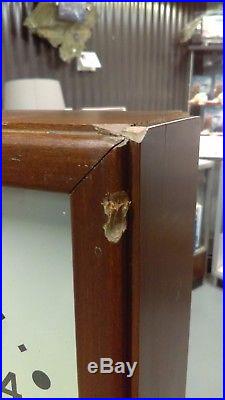
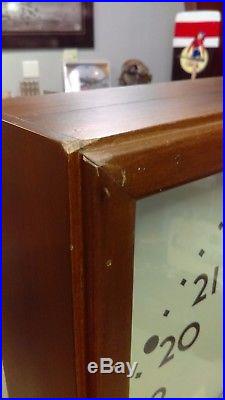
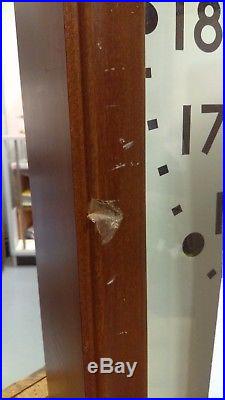

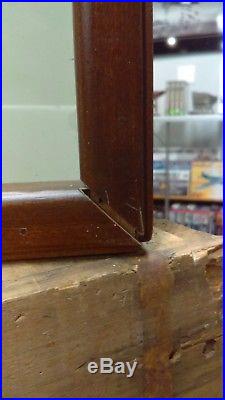
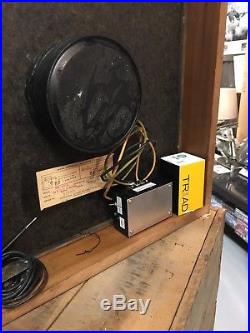
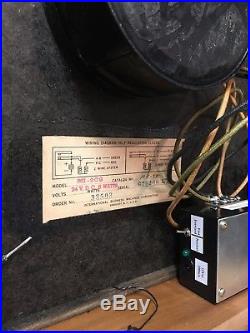


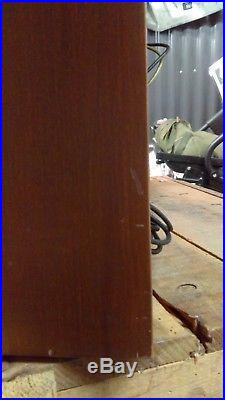


The size is 19.5 x 19.5 x 4 3/8 inches deep. The following information has been researched and compiled by the volunteers of the National Museum of World War II Aviation in Colorado Springs, CO. 100% of the proceeds from the sales of this item will be reinvested into the museum’s programs. We have several of these clocks available and will be listing them all over time. This specific clock has slight damage to one of the corners(see photos) so please check back often for clocks in better condition. If you have additional requests for information, we will be happy to respond to messages within 48 hours. Your International clock is a vintage Minute Impulse Secondary Clock (also called slave clock) manufactured in the early 1940s by International Business Machines Corporation, better known today as IBM. The Endicott, NY plant that made it was built in 1906 and the building is still used by IBM today. Your clock is one of a lot discovered in old unopened wooden crates obtained by the museum in 2014. The clocks were made for the US Army Air Force (AAF), the successor to the Army Air Corps and the forerunner of todays US Air Force. Serial numbers indicate they were made in 1942 and 1943. They were inspected, packaged and crated at the AAFs 829th Specialized Depot (829 SP D) at Gadsden, Alabama, in July 1945, shortly before the end of WWII. Between manufacturing and crating, they may have been in service or in storage; we have no way of knowing for certain, but some do appear to show wear from use. Four clocks were packed per crate with each clock wrapped in brown paper and then sealed against moisture with tarred paper. Even so, after 70 years of slow oxidation the mechanisms had become inoperable. Museum restoration staff disassembled, cleaned and restored these to operating condition using all the original parts (unless broken or beyond repair). The 829th SP D inspection tag from its outer wrapper accompanies your clock. Minute Impulse Secondary Clocks. Invented around the turn of the 20th Century, secondary (slave) clocks were used in large institutions such as factories, schools and military bases that needed to show the same time in many locations at once. Large numbers of secondary clocks could be remotely controlled over wires by a master clock that might be located in a principals office for a school or a headquarters office for the military. Master/slave time systems are still in production using modern technologies. The impulse type of secondary clock is not a true clock; by itself, it cannot keep time. The minute-impulse clock received a pulse of current from its master clock each minute to advance the hands. Minute impulse clocks are sturdy and use no power save a small amount when advancing the hands. The basic design of your clock was first patented in 1928 by Clinton E. Larrabee and assigned to the International Time Recording Company, Ltd. One of the forefather firms that eventually became IBM. A master clock was a precision time-keeping device that, for your clock model, sent a 24-volt pulse over a pair wires each minute to advance all the hands of all its slave clocks (note that this model, 561-2CG, did not come with second hands). At five minutes to the hour, a temporary change occurred to the scheme to correct any clock that had missed one or more pulses. Note: we have placed a small jumper wire across the switch terminals. The switch is not used and the jumper prevents possible poor contact problems. The Museums Clock Driver Unit. Museum staff designed and constructed a small clock driver unit powered by a wall wart to provide master clock pulses so your clock can keep time. A fast-forward switch on the driver box can be used to advance the clock if it falls behind the actual time. Fast-forward advances the hands by 3 minutes per second and through 24 hours in just eight minutes. If your clock is close to a full 24 hours behind, you may find it easier to turn it off, let it fall a little behind actual time, and then fast forward to set it. A green LED lights when power is applied and it winks each time a pulse is sent to the clock. Some of these clocks also have a buzzer attached to the back of the case. These operate on 24 volts AC, but we have not provided a unit to power them. It does not matter which way the clocks wires are attached to the screw terminals on the driver box; it is not polarity sensitive. The red wire goes to one terminal and the black and green wires to the other (note the original wire colors are faded by time). The construction of these antique clocks imposes some operating limitations. They cannot be reset by pushing the hands around because there is no way to open the front of the clock. Accessing the hands requires taking the case apart from the back. And the internal mechanism can only be advanced, not run backward; therefore, setting them sometimes requires a bit of patience, as befits a product of a simpler time. Finally, though the clocks sport a gray Greenwich Mean Time (GMT) hand, it is fixed in relation to the black hour hand; therefore, wherever Daylight Savings Time is in use, the GMT offset cannot be relied upon to be correct. Reading Your Serial Number. Your clocks serial number is on a label on the clocks backside. The Model number on the label, 561-2CG, apparently refers only to the impulse mechanism because we have seen the same model number on several quite different-looking clock case designs. The Catalog number on the label apparently defined the actual case appearance. All sales are final. However, if your clock stops working, please contact the Museum. We will make every attempt to try to solve the problem. The item “IBM US Army Air Force 24hr Vintage Minute Impulse Secondary Slave Clock WORKS” is in sale since Thursday, October 05, 2017. This item is in the category “Collectibles\Clocks\Vintage (1930-69)\Wall”. The seller is “namowwiia” and is located in Colorado Springs, Colorado. This item can be shipped to United States.
- Brand: IBM
- Country/Region of Manufacture: United States



